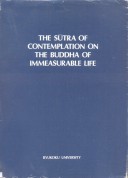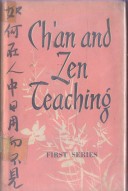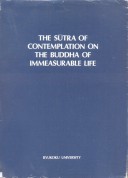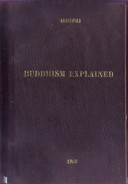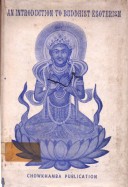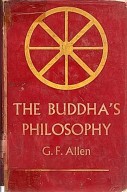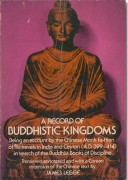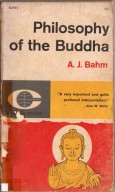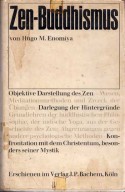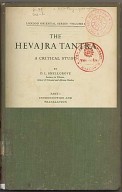Tìm Sách
Sách tiếng Anh-English >> A Short Introduction of Buddhism in Vietnam
Thông tin tra cứu
- Tên sách : A Short Introduction of Buddhism in Vietnam
- Tác giả : Venerable Quang Lien
- Dịch giả :
- Ngôn ngữ : Anh
- Số trang : 65
- Nhà xuất bản : Commissione General For Education, Cultural and Social Welfare. The Unified Buddhist CongregationSaigon
- Năm xuất bản : 1968
- Phân loại : Sách tiếng Anh-English
- MCB : 12100000002743
- OPAC :
- Tóm tắt :
A SHORT INTRODUCTION OF BUDDHISM IN VIETNAM
Venerable Quang-Liên
1968
SAIGON
Ven. QUANG-LIÊN was born in 1926. He studied in Colombo from 1951 — 1956 and graduated at University of Ceylon. He received M. A. degree from Yale University, Conn. U. S. A. in 1960.
He is now Professor at Saigon University — Principal of Bo - De High School, — A member of National Education Council — Commissioner General for Education. Cultural and Social Welfare, The Unified Buddhist Congregatio
PUBLISHED BY
Commissione General For Education, Cultural and Social Welfare.
The Unified Buddhist Congregation
243, Sv-van-Họnh, $t. Saigon — Vietnam
PREFACE
BUDDHISM had been introduced to Vietnam nearly 2000 years ago. Vietnam is one of the Buddhist countries in South-East-Asia, The majority of its population are Buddhits, judging from the custom of their daily life. Buddha's Teachings spread throughout every part ot the country and influence on culture, custom, and phiosophical way of life.
The doctrine of Buddha is deep and lofty. It cannot be described in one single book or two. The purpose of this Short Introduction of Buddhism in Vietnam, written in English, is to present some of the main points of Buddha's Teachings and a brief account of Buddhist history in Vietnam to the readers who are already more or less acquainted with the funda-mental idea of Buddhism. My effort has been also directed towards offering as brief as possible for the benifit of foreigners who are now working in Vietnam, unable to read Buddhist books in Vietnamese language, knowing somethings of Buddhist activities.
It is hoped that this book will be found useful by the foreign readers in particular and by the public in general.
Constructive criticisms either on general matter or on points of detail will be greatly appriciated.
Venerable Quang-Liên
Saigon, Spring 1968.
CONTENTS
j,— The life of Gautama Buddha.
II, — The Basis of Buddhism
— The Four Noble Truths.
— The Eightfold Path.
— Karma and Rebirth
III. — The Introduction of Buddhism in Vietnam.
— Development of Buddhism in Vietnam,
— Buddhist Sects
THE LIFE OF GAUTAMA BUDDHA
BUDDHISM is founded by Gautama Buddha. The life of Gautama Buddha, the light of Asia is fairly well-known.
In the 6th century B.C. there lived at Kapilavastu in the North-East of India, an Aryan tribe, the Sakya, who was a prince, the son of King Suddhodana and Queen Mahamaya Divi. It was said that the Queen was the purest woman on earth.
It was known that, one night Queen Mahamaya had a dream that a Bodhisattva descended from Tusita heaven in the form of a white elephant with a lotus flower presented to her and entered her womb at the right side.
This news was announced, King Suddhodana was absolutely happy and preparedfor the birth. According to the custom of India, the Queen should have gone to her family lo give birth. On the way to her family, the Queen took a rest in the Lumbini park which was a pleasure and beautiful grove of the King. In the Lumbini park, she suddenly gave birth to a son, called Siddhartha. this was on the full-moon day of May in 623 B.C.
At that moment many wonders took place in the world. The new-born Prince who walked on lotuses at the moment of his birth and proclaimed: "I rank as the highest in the world.
1 am supreme in the world.
I am the chief in the world and this is my last incarnation".
After seven days giving birth to the child, the Mother Queen died and Maha Prujapati, her younger sister who was the next Queen of king Suddhodana, brought up the Prince in great luxury and comfort. King Suddhodana built three different palaces for the Prince to stay alternately in the hot, cold and rainy seasons.These palaces were carefully provided With beautiful gardens, and teachers invited to teach him all arts and sciences, but he had no permission lo leave the palaces. For Asita, a great ascetic foretold that hewould renounce the household life and become a wandering monk.
Prince Siddhartha was the heir of the ruling house of the Sakya in future. When he came to age, King Suddhodana sought a beautiful wife for his son ; for he thought that if they were tied to each other in bonds of matrimony, he would be attached to the worldly life. Yaso- dara the most beautiful princess of King Suppabuddha, a monarch of the neighboring kingdom of Koliya, was chosen as his lovely and beautiful wife. In this way, the King thought that his son might he happy with his lovely wife and the delights of wealth that would cause him without thinking of becoming a recluse.
In his 29th years old while he was making his sightseeing trips around the Royal capital, accompanied by Channa. his charioteer and hostler, the Prince saw an old man. a sick-man and a dead body respectively, and got thoroughly disgusted of the human world. These three scenes touched his mind and gave him the first glimpse of the fact that every one who is born in this world should become old. then sick and dead. But at the last time, he saw a recluse in yellow robe, a ray of hopethe month of Asala. headed by the five monks. The Dhama-cakka-sutta embodies the whole essence of the doctrine. It disclosed the fact that Enlightenment could he attained only by treading along the middle path also called the Noble Eightfold Path, which gave up the two extreme Self-mortification and self-indulgence. The Buddha taught :
« There are two extremes :
III, The path of freedom is the middle path between ascetism and sensuality, the way of rational self-control.
IV, The restless cravings of self disappear in the life of love and of devotion to the service of others.
In short the Middle Path comprises Morality, Wisdom and Concentration which are conducive to the realization of the four Noble Truths namely (1) suffering, (2) the cause of suffering, (3) cessation of suffering and (4) the path leading to the cessation of suffering that is the Noble Eightfold Path :—
(1) Right vision, (2) Right Aims, (3) Right words, (4) Right Livelihood, (5) Right actions, (6) Right Mindfulness, (7) Right Effort and, (8) Right Meditation. It is only by the realization of the Four Noble Truths that one can endsuffering and reach everlasting bliss. The new doctrine of the Awakened-One who devoted his time exclusively for the benefit of others and shook the old tradition of India, for he denied entirely the traditional gods, religious beliefs and customs. The Buddha's teaching rests on the idea of knowing reality as it is. That means one should know the true facts of this earthly life and look at it without making excuses, regulating their daily lives in accordance with the Middle path. He taught that man can gain his deliverance and purification by his own exertion without depending on God, or Gods. He revolted against the degrating caste-system and taught equality of mankind and gave equal opportunities for all men and women a democratically constituted celibate order. Because of this doctrine, the right Way of life, the caste system which was deeply rooted in Indian soil, became badly shaken. As the Buddha said »
« Mot by birth is one a Vasala
Not by birth is one Brahmana
By deeds is one a Vasala
By deeds is one a Brahman »
Buddha also proclaimed, true wealth is thenoble transcendent doctrine. Anyone whatever his caste is, may practise this and develop the thought of compassion and freedom from enmity. The Buddha was a man-an extraodin- ary one, it is true — and died as a man. Every thing about him was inequivocally within the domain of Nature. What he had done, and taught, every other human being could do so, if they chose to and was prepared to make the requisite effort. The Buddha who served humanity for 45 years, preaching his Dharma, the Real- Truth which he gave to the world as a way of life, telling men and women how they should employ this existence in order to achieve suppreme happiness. The Buddha the finest example of human perfection passed away at the Sala grove in Kusinara when he was 80 years of age. The Buddha addressed his disciples and said :
« All component things are subjected to decay.
Work out your own salvation with diligence.»
He lay down on his right side and reached Nirvana the Highest State of Peace and Freedom on the full-moon day about 543.B.C.
THE BASIS OF BUDDHISM
The Four Noble Truths
As it is said. Buddhism is the way of
life. The message of Buddha's Enlightenment points to man the way of life that leads beyond suffering. The Teaching of Buddha bases on the clear comprehension of actuality. It is the doctrine of the Fourfold Truth dealing with the fundamental facts of life and with liberation attainable through man's own effort towards purification and insight. According to Buddhist teaching, it gives expression of the cessation of existence as a human being and emergence into eternal being
Buddha’s teaching offers a lofty but realistic sytem of life, a profound philosophy, practical methods of mind training, these havecome to be known as the doctrine of the Four Noble Truths (catvari-Ariyasatyani) which are the principles and the basis of Buddhism.
The four noble truths are : —
V, The Noble Truth of suffering (Dukkha).
VI, The Noble Truth of the Origin of Suffering (Dukka-Somudays)
VII, The Noble Truth of the Extinction of Suffering (Dukkha Niroddha)
VIII, The Noble Truth of the Path that leads to ths Extinction of Suffering (Dukkha Nirodha gamini patipada)
I) Whati now, is the Noble Truth of Suffering ?
The sights of suffering which upset the mind of Prince Siddhartha, were of disease, old age and death.
Birth is suffering, decay is suffering, death is suffering, sorrow is suffering, lamentation, pain, grief and despair are suffering, not to get what one desires is suffering, in short the Five groups of Existence are suffering.
People know that there is sufferingand sorrow in the world but it was only the Buddha who with his supreme wisdom saw that everything is sorrow fraught. Nobody can escape the suffering of birth, old and death. Our body composes of five groups of existence and four elements : earth, water, fire and wind which are impermenant (anicca), full of sorrow and decay. The Buddha does not want his followers to be constantly brooding over this fact of suffering for he shows a way how people could get rid of suffering and sorrow. Buddhism is therefore, neither pessimism nor optimism. The A wakened-One himself says : «One thing only do I teach, that is suffering and the cessation of suffering a.
(2) What, now, is the Noble Truth of the Origin of Suffering ?
That is craving, egoistic desires which give rise to fresh rebirth accompanied by passionate clinging vis, desire for sensual pleasure and lust, now, here, now there, finds ever fresh delight.
The origin of life's suffering is explained by Buddha in the light of his special conceptionof natural causation. According to it, nothing is unconditional, the existence of everything depends on some conditions, suffering in life is dependent on birth (Jati), Birth is dependent on the will to be born (Bhava). Bhava is dependent on our mental clinging (upadana), Mental clinging is dependent on craving or desire (Tanha) for objects, Craving is dependent on sensation (vedana) Sensation is dependent on contact (phrassa), Contact depends on the six organs of cognition, The six organs are dependent on Mind and matter (Nama Rupa), Mind and matter are dependent on consciousness (Vinnana), Consciousness is dependent on volitional activities (shankhara) Volitional activities are dependent on ignorance (Avijja).
Craving (Tanha) however is not the only cause of evil action, and thus all the suffering and sorrow, produced thereby in this and next life, but wherever there is craving, there, dependent on craving, may arise envy, anger, hatred and many other evil things productive of sufferings and miseries.
(3) What now, is the Noble Truth ef the Extinction of suffering ?
It is the complete fading away and destructionof craving, egoistic desires, its forsaking- renunciation,liberation and detachment from it,
The Third Noble Truth that there is cessation of suffering which follows the second truth that sorrows are dependent on some conditions. If these conditions are removed, misery would cease. When sufferings and cravings completely vanish, the mind is calm and peaceful, then is no longer under the sway of worldly attachment. It is, therefore, free, liberated. It is said then to have attained Nivarna — The state of extinction of craving.
(4) What, now is the Noble Truth of the Path Leading to the Extinction of Suffering ?
It is the Noble Eightfold Path (Ariya attan - gikamagga) which is the way leading to the destruction of thirst, craving suffering...
The noble eightfold path is :
IX, Right knowledge (Samma-ditthi) is the cause of Right Aspiration
X, Right Aspiration (Samma-Sankappa) is the cause of Right speech
XI, Right speech (Samma-Yaca) is the cause of Right action.
XII, Right action (Samma-Kam manta) is the cause of Right occupation.
XIII, Right occupation (Samma-Ajiva) is the cause of Right Exertion
XIV, Right Exertion (Samma-Vayama) is the cause of Right Mindfullness.
XV, Right Mindfullness (Samma-Sati) is the cause of Right concentration.
XVI, Right concentration (Samma - Samadhi) leads to Right knowledge of realisation which leads to Nirvana.
The Noble Eightfold Path is the Middle Path avoiding the two extremes of self - indulgent materialism and self - mortifying asceticism, which the Enlightened - One has found out, which makes one both see and know, which leads to peace, to Enlightenment, to Nirvana. This Path is open to all, monks as well as laymen.
KARMA ANH REBIRTH
The Cause and the Effect
In Buddhism, Karma is one of the most important questions. Karma means the law of ethical causation with its inevitable retribution or effectivity. Rebirth is its corollary. Karma and Rebirth are inter-related fundamental theory in Buddhism.
There are two kinds of karma : Kusala- karma (virtuous action) and Akusala-Karma (bad action). The virtuous karma will have a good reward ( ), the vicious karma vill have an evil recompense ( ).
It is true that according to the doctrine, every karma has its activity to produce a reaction upon the doer. The present existence of an individual is as according to that ofkarma, the effect of its past; and its future would be the effect of its present existence. Some of us in the world are brought up in the lap of luxury, endowed with wealth, power and happiness, while others are faced with poverty, failure, and suffering. Some other religions speak of an almigty god who created heaven earth and every tiling of the universe ; happiness or suffering, wealth or poverty of mankind is given by God. It is. we think, not true and right. According to Buddhism, no creator created us to fill a wish of His. but instead, we are the direct result of actions or karma. There must be a cause or causes for this inequality of mankind. In this world nothing happens to any person that he does not deserve for some reasons or others.
The Re-birth consciousness is one connection of cause and effect, and the animation of all living beings is result of their past karma, and the result of their present karma will in turn govern their future lives, in a chain of rebirth, The Buddhist teaching of rebirth should however be differentiated from the transmigration and reincarnation of other system, because Buddhism denies the existence of a transmigration permanent soul, created by God, or Brahma.In Majjhima Niknva (he Buddha says,:All living beings have action (karma) of their own, their inheritance their congenital cause, their kinsman, their refuge. It is karma that differentiates all living beings into low and high states"
«According to the seed that is sown.
So is the fruit ye reap there from,
Doer of good will gather good Doer of evil, will evil reap,»
As we have mentioned above. There are two kids of karma kusala-kurnia and Akusala-karina.
Kusala-karma is any action in confermity with rectitude and righteousness" whether in deed, word and thonght. The effeet of good karma generally accurs in the form of happiness.
The follwing ten actions which we find in Buddha’s teaching, ar
e the good actions (kusala karma) should be practised by Buddhists.
1/ Dana or generosity
2/ Sila or Morality
3/ Rhavana or Meditation
4/Apacavana or Reverence
5/ Veyyavacca or service
6/ Pattidana or transference of merit
7/ Pattinumodana or Rejoicing in others’- merit
8/ Dhammasavana or hearing the Dharma
9/ Dhamma desana or Espounding the Dharma
10/ Ditthijjukamma or having right views. The following actions which called Akursala karma or bad actions, should be avoided :
Killing These three are be-
Stealing longed to Bodily
Unlawful sexual intercourse actions
Lying
Tale bearing
Harsh speech
Frivolous talk
These belonged toMental actions
To keep away from evils is to avoid all miseries and sufferings, and to repress a moment’s anger may save a decade of years of sorrow. Do not estrange a man from his wife as it is a crime against humanity.
The path of salvation lies through karma,
These belonged to Verbal actions
Covetousness 111 - will False view and karma marked by virtue is higher grade of existence
leading step bystep the way
ocean of transmigration.
conductive to in future lives out of the
III
THE INTRODUCTION OF BUDDHISM IN VIETNAM
There is no doubt that the birthplace of Buddhism is in India. The Teachings of the Buddha were firstly introduced to various countries of the North and South of India at the age of Asoka dynasty about four centuries B.C by Buddhist Missionaries, sent by king Asoka.
The origin of Budddhism in Vietnam is not definitely recorded but, according to some authorities and the earliest available record, the religion was flourishing at the end of second century of Christian era. Vietnam was linked to China and India, lying as it is on the ancient routes. As a result, Indian Buddhist Missionaries touched the country, particularlycalling at Camppa on the South-Coast,
According to a Chinese record, the South- Indian Vinitaruci Thera who came to China in 547 (the year in which Bodhi-Dharma arrived in the same country) and then proceeded to Vietnam and founded a Dhyana School at the «Cloud of the Dharma» Monastery (chua Phap Vân) and translated the sutras.
Looking backwards of the world Buddhist history, we understand that Buddhism, from India, was widely spread to the neighbouring countries by two means : land and sea. By the landway, Buddhism was brought, from Indian to Tibet, China, Vietnam Mongolia and from there it spread to Korea and then Japan. By the sea route it was brought into Ceylon, Java Indonesia, Vietnam and China.
The length of Vietnam’s coast, together with the fact that it is running close to the sea route connecting India with China and China with the main islands of Indonesia, is the reason we know that Buddhism was not only brought into Vietnam by land route but also by the sea route For this reason we also understand that Buddhism had been introduced to Vietnam much earlier than Rev. Vinitaruci-Thera did in 547 AD.
However, several different sources which were left behind by the Vietnamese monks.in 13th and 14th centuries noted that, in the Han dynasty of 2nd and 3rd certuries, Rev. Marijivaka, Khuong Tang Hoi and Meou-Po etc... came to Vietnam either by land or by sea route for propagating Buddhism.
Ngo-Chi's books of China said : «Sỉ-Nhiếp who was since Vice-Governor of Giao-Chau state, much respected by the local people. So at any time when he went out, group of Ho people going along the road beat the drums and gongs and burnt incenses as an act of respect». Such way of respect was similar to that of Buddhism in India and Ceylon.
According to Sylvain-Levi’s remark the word «Ho» used by the Chinese ỉn the third century to show the western area poeple. So the Ho were perhaps, the people came from India or Mid-Asia, influenced by Indian Religions.
Reverend Dam - Thien’s book wrote : «King Cao-To of Tuy (Sui) told Rev Dam Thien « I think of the Compassionate way of Sakya - Muni - Buddha which is priceless.
 Facebook
Facebook
 Google
Google
 Google+
Google+
